Top 10 Foods Highest in Selenium
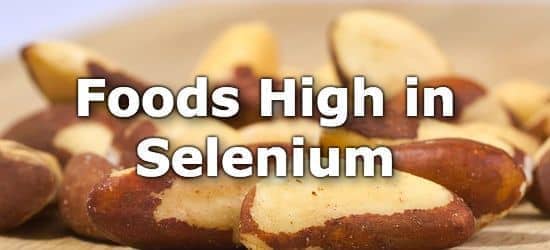
Selenium is an essential trace mineral with a variety of functions in the body. Most notably selenium is essential for proper thyroid function and for supporting a healthy immune system. (1,2)
A deficiency in selenium is associated with poor cardiovascular health, infertility, and cognitive decline. (3)
Foods high in selenium include Brazil nuts, tuna, oysters, pork, beef, chicken, tofu, whole wheat pasta, shrimp, and mushrooms. The current daily value (DV) for selenium is 55mcg (micrograms). (4)
Below is a list of high selenium foods sorted by common serving size, please see the complete ranking of all foods high in selenium for more.
List of Foods High in Selenium
-
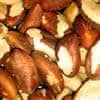 1. Brazil Nuts + Add
1. Brazil Nuts + Add
Selenium
per 1oz HandfulSelenium
per 100gSelenium
per 200 Calories544.4mcg
(990% DV)1917mcg
(3485% DV)581.8mcg
(1058% DV)More Nuts and Seeds High in Selenium
- 41% DV in 1oz of sunflower seeds
- 29% DV in 1oz of chia seeds
- 13% DV in 1oz of flax seeds
See all nuts and seeds high in selenium.
-
 2. Tuna (Yellowfin) + Add
2. Tuna (Yellowfin) + Add
Selenium
in a 6oz FilletSelenium
per 100gSelenium
per 200 Calories183.9mcg
(334% DV)108.2mcg
(197% DV)166.5mcg
(303% DV)More Fish High in Selenium
- 168% DV in a 6oz tilapia fillet
- 151% DV in a 6oz snapper fillet
- 145% DV in a 6oz salmon fillet
See all fish high in selenium.
-
 3. Shellfish (Oysters) + Add
3. Shellfish (Oysters) + Add
Selenium
per 3oz ServingSelenium
per 100gSelenium
per 200 Calories130.9mcg
(238% DV)154mcg
(280% DV)189mcg
(344% DV)More Shellfish High in Selenium
- 221% DV in 20 small clams
- 138% DV in 3oz of mussels
- 113% DV in 3oz of lobster
See all fish high in selenium.
-
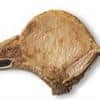 4. Lean Pork Chops + Add
4. Lean Pork Chops + Add
Selenium
in a 6oz ChopSelenium
per 100gSelenium
per 200 Calories80.6mcg
(147% DV)47.4mcg
(86% DV)48.6mcg
(88% DV)More Pork High in Selenium
- 122% DV in 1 cup of lean roast ham
- 87% DV in a rack of ribs
- 74% DV in 3oz of pork tenderloin
- 71% DV in 3oz of Spam
See all meats high in selenium.
-
 5. Beef (Skirt Steak) + Add
5. Beef (Skirt Steak) + Add
Selenium
per 6oz SteakSelenium
per 100gSelenium
per 200 Calories61.2mcg
(111% DV)36mcg
(65% DV)26.9mcg
(49% DV)More Red Meats High in Selenium
- 85% DV in a 4.6oz ribeye fillet
- 64% DV in 3oz of buffalo sirloin
- 49% DV in 3oz of lamb shank
See all meats high in selenium.
-
 6. Lean Chicken Breast + Add
6. Lean Chicken Breast + Add
Selenium
in a 6oz BreastSelenium
per 100gSelenium
per 200 Calories54.2mcg
(99% DV)31.9mcg
(58% DV)40.6mcg
(74% DV)More Poultry High in Selenium
- 121% DV in a whole chicken leg
- 97% DV in 6oz of fat-free ground turkey
- 63% DV in 1 chicken thigh
See all meats high in selenium.
-
 7. Firm Tofu + Add
7. Firm Tofu + Add
Selenium
per CupSelenium
per 100gSelenium
per 200 Calories43.8mcg
(80% DV)17.4mcg
(32% DV)24.2mcg
(44% DV)More Beans High in Selenium
- 28% DV in 1 cup of canned navy beans
- 19% DV in 1 cup of pinto beans
- 15% DV in 1 cup of lima beans
See all beans high in selenium.
-
 8. Whole Wheat Pasta + Add
8. Whole Wheat Pasta + Add
Selenium
per CupSelenium
per 100gSelenium
per 200 Calories42.5mcg
(77% DV)36.3mcg
(66% DV)48.7mcg
(89% DV)More Whole Grains High in Selenium
- 100% DV in 1 cup of kamut
- 23% DV in 1 cup of oatmeal
- 21% DV in 1 cup of brown rice
See all grains high in selenium.
-
 9. Shrimp + Add
9. Shrimp + Add
Selenium
per 3oz (About 12 Large)Selenium
per 100gSelenium
per 200 Calories42.1mcg
(77% DV)49.5mcg
(90% DV)83.2mcg
(151% DV)See all fish high in selenium.
-
 10. Shiitake Mushrooms + Add
10. Shiitake Mushrooms + Add
Selenium
per Cup CookedSelenium
per 100gSelenium
per 200 Calories36mcg
(65% DV)24.8mcg
(45% DV)88.6mcg
(161% DV)More Mushrooms High in Selenium
- 48% DV in 1 cup of portabellas
- 41% DV in 1 cup of criminis
- 34% DV in 1 cup of white button mushrooms
See all vegetables high in selenium.
Printable One Page Sheet
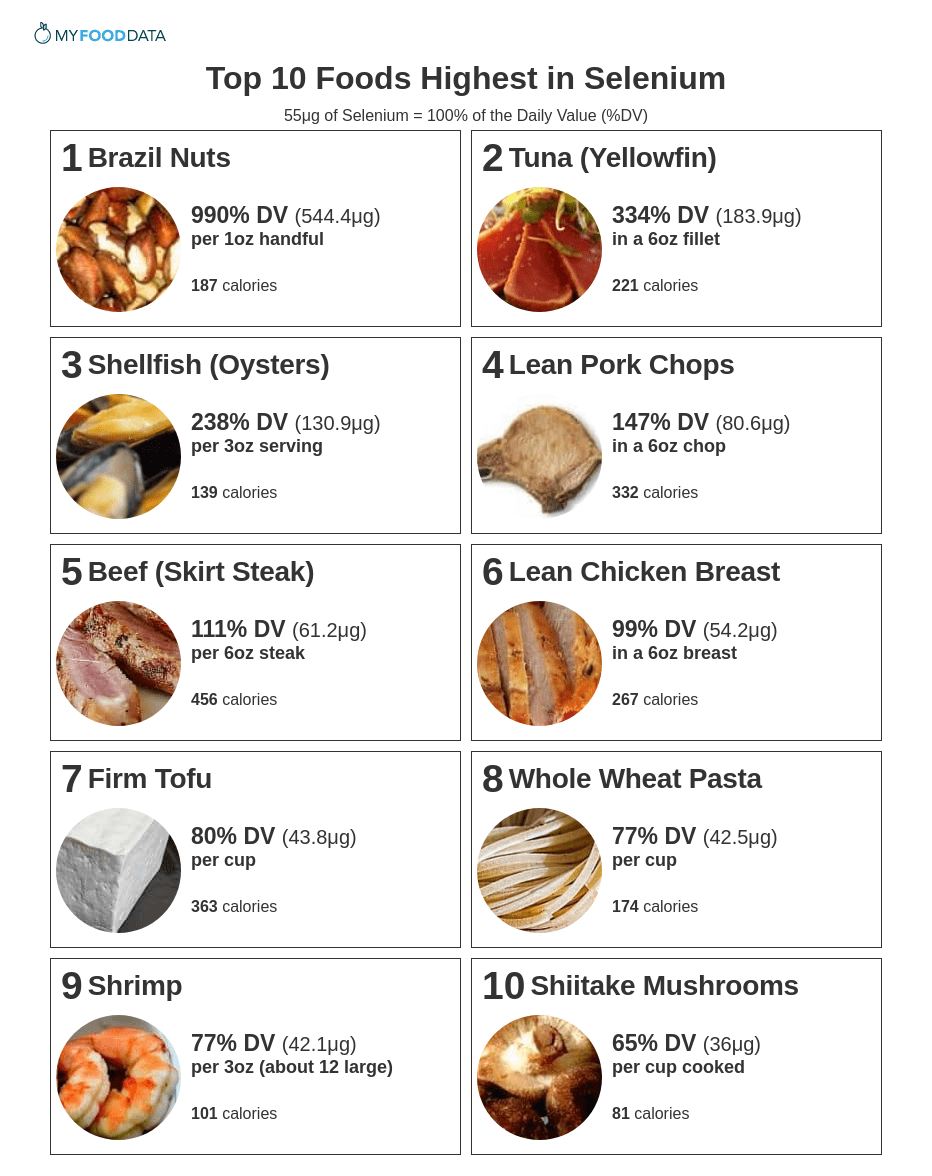
Selenium Foods by Nutrient Density (Selenium per Gram)
| Food | Serving | Selenium |
|---|---|---|
| 1. Brazilnuts + | 100 grams | 3485% DV (1917mcg) |
| 2. Cooked Pacific Oysters + | 100 grams | 280% DV (154mcg) |
| 3. Cooked Lamb Liver + | 100 grams | 211% DV (116.1mcg) |
| 4. Cooked Yellowfin Tuna + | 100 grams | 197% DV (108.2mcg) |
| 5. Cooked Blue Mussels + | 100 grams | 163% DV (89.6mcg) |
| 6. Octopus (Cooked) + | 100 grams | 163% DV (89.6mcg) |
| 7. Dry Roasted Sunflower Seeds + | 100 grams | 144% DV (79.3mcg) |
| 8. Canned Anchovies + | 100 grams | 124% DV (68.1mcg) |
| 9. Canned White Tuna (Water Packed) + | 100 grams | 119% DV (65.7mcg) |
| 10. Toasted Wheat Germ + | 100 grams | 118% DV (65mcg) |
Selenium Requirements By Age and Gender
The recommended daily allowance (RDA) for selenium ranges from 15mcg to 70mcg per day. (5) The daily value for selenium is 55mcg per day. (4)
| Life Stage | RDA |
|---|---|
| Infants* | |
| 0-6 months old | 15mcg |
| 7-12 months old | 20mcg |
| Children | |
| 1-3 years old | 20mcg |
| 4-8 years old | 30mcg |
| Males | |
| 9-13 years old | 40mcg |
| 14-18 years old | 55mcg |
| 19-50 years old | 55mcg |
| 50+ years old | 55mcg |
| Females | |
| 9-13 years old | 40mcg |
| 14-18 years old | 55mcg |
| 19-50 years old | 55mcg |
| 50+ years old | 55mcg |
| Pregnancy | |
| 14-18 years old | 60mcg |
| 18+ years old | 60mcg |
| Lactation | |
| 14-18 years old | 70mcg |
| 18+ years old | 70mcg |
Source: Dietary Reference Intakes for Selenium.
From the Nutrient Ranking Tool
Use the ranking tool links below to select foods and create your own food list to share or print.
- Foods High in Selenium
- Foods Low in Selenium
- Vegetables High in Selenium
- Fruits High in Selenium
- Vegetarian Foods High in Selenium
- Nuts High in Selenium
- Beans High in Selenium
- Dairy High in Selenium
- Breakfast Cereals High in Selenium
- Fast Foods High in Selenium
View more nutrients with the nutrient ranking tool, or see ratios with the nutrient ratio tool.
Related
Data Sources and References
- Orskov H, Flyvbjerg A. The importance of selenium to human health Lancet. 2000 Sep 9;356(9233):942-3. doi: 10.1016/S0140-6736(05)73926-X. 11036921
- Minich WB. Biological Activity of Selenium and Its Impact on Human Health Biochemistry (Mosc). 2022 Jan;87(Suppl 1):S168-S102. doi: 10.1134/S0006297922140139. 35501994
- Holben DH, Smith AM. Selenium Deficiency J Am Diet Assoc. 1999 Jul;99(7):836-43. doi: 10.1016/S0002-8223(99)00198-4. 10405682
- U.S.FDA - Daily Value on the New Nutrition and Supplement Facts Labels
- NIH - Dietary Reference Intakes for Vitamin C, Vitamin E, Selenium, and Carotenoids.
- Office Of Dietary Supplements Fact Sheet
Simplify Nutrition Tracking with MyFoodData!
Speedy Tools and Detailed Data FREEEasily analyze your meals to find the best foods for your goals.
✅ Use our recipe nutrition calculator and nutrition comparison tool.
✅ Access expert nutrition data tools and in-depth articles.
✅ Log foods and organize your recipes with a free account.


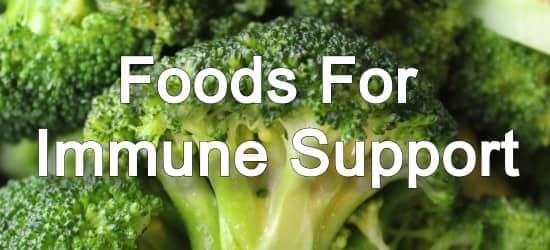 Next ➞
Next ➞
